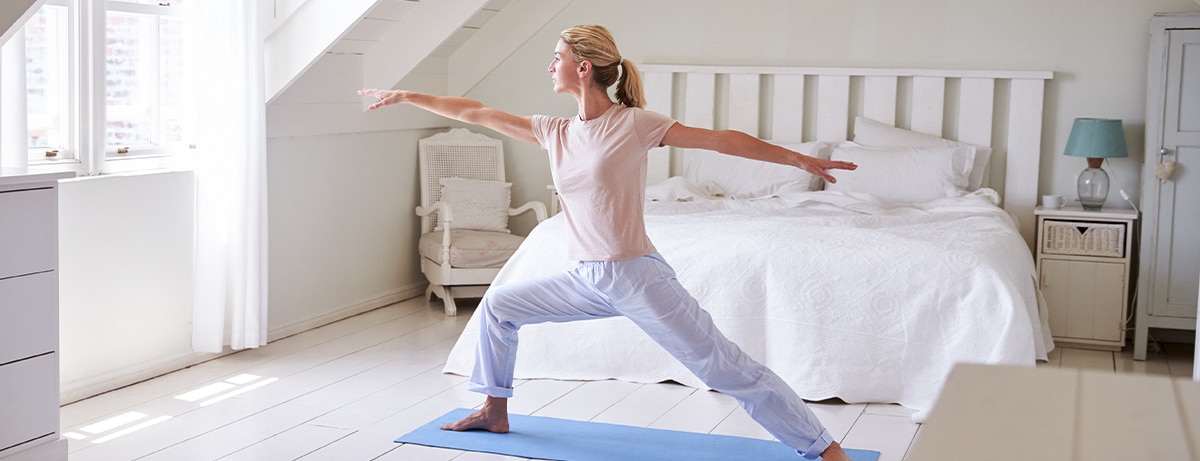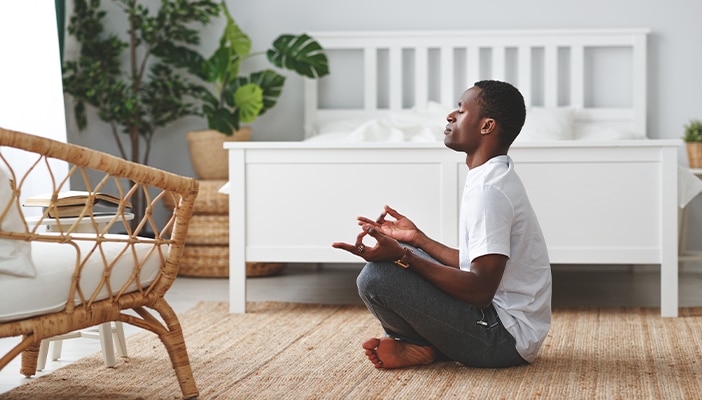20% off €40
Morning yoga for beginners

Spending 15 minutes each morning flowing through some yoga poses can help to improve your flexibility, core strength, and balance – which makes it a great addition to your morning routine.1
Why is yoga in the morning beneficial?
Studies have shown that yoga can help improve your physical and mental health, including reducing physical symptoms associated with anxiety.2 Alongside this other studies have shown yoga can switch off your ‘fight-or-flight’ response temporarily, which helps calm your mind.3
How do you get started with a morning yoga routine?
Before you begin your yoga practice, you want to take a couple of minutes focusing on your breath. Either sit in a cross-legged position, or stand with your hands by your side in mountain pose, and take notice of your breathing.
Spend time filling your lungs with long inhales, and then follow this with exhaling through your nose. When you get into your practice, you want to keep your breathing steady, and hold each pose for two breaths before moving on to the next.


What yoga poses help wake you up?
- Side stretch
From either a seated or standing position, raise your hands slowly above your head. Remember to focus on your breathing and keep your heart in line with your pelvis. Hold your arms above your heard for a breath, before you gently tilt to the right. You’ll feel the stretch down your side abdomen. Come back to the centre, and then repeat on the opposite side.
- Plank
Planking is one of the most popular poses, and probably the one you’re already most familiar with. Kneel forward, and walk your hands out, so your body is horizontal to the ground. From here, lift up onto your palms, or your elbows, and keep a straight line with your body down to your toes. Hold this for two breaths, and release.
- Cobra
From your stomach, anchor your pelvis on the floor and lift your chest. Make sure your palms are planted on the ground next to your shoulders whilst you hold this stretch. If you want to try a deeper stretch, straighten your arms and lift your chest even higher.
- Downward dog
Downward Dog is a great yoga pose for any time in the day, however, it’s particularly beneficial in the morning. Bend your knees slightly and bring your hands to the ground. Slowly walk them forward and begin to straighten your arms and legs.
You should be forming your body in an upside-down v shape. Once you’re there, hold the pose in a place wherever feels comfortable for you – if this means bending your legs slightly, then go ahead and do this.
- Childs pose
This pose helps to stretch your lower back and ankles. Simply sit down on your feet, and slowly lean forward until your stomach is on top of your thighs. Gently stretch your arms forward and rest your forehead on the ground. Hold for a couple of breaths.
- Twisted lunge
From standing, step your right foot forward, bending your front knee into a lunge. Gentle place your left hand on the ground and raise your right hand in the air. This will open up your chest, and help to stretch out your entire side body. Hold for two breaths, and repeat on the opposite side.
- Lizard stretch
This pose is a little bit more advanced. However it feels incredible. From your lunge, let your back knee touch the ground and slowly raise your forearms to the earth. Hold this deep stretch for a couple of breaths, before switching to the opposite leg.
- Half moon pose
The half moon pose is the most advanced on the list, so if you’re a beginner, you might want to gradually build up to this. It’s an incredible pose for balance, and helps align your centre.
From standing, start to slowly bend forward so your chest is horizontal to the ground, keeping your right leg grounded on the earth. After you’ve found your balance, slowly begin to reach your right hand to the ground (feel free to use a book or yoga block to bring the earth closer to you).
From here, raise your left leg straight out, creating a parallel line to the ground, from the top of your head, to the tip of your toe. Open your chest and raise your left hand to the sky. Hold this pose for 2 breaths and switch sides.



